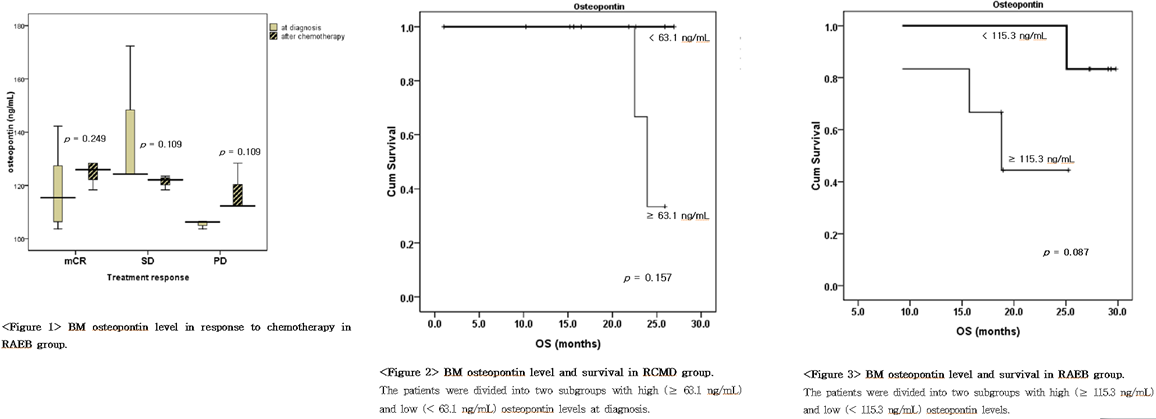Division of Hematology & Oncology

Contributions
Type: Publication Only
Background
Osteopontin, a glycophosphoprotein encoded by a single gene on chromosome 4q13, is expressed and secreted in numerous human cancers and plays a role in tumor progression and metastasis. Also, high osteopontin level is associated with shortened survival in hematologic malignancies. Bone marrow (BM) osteopontin levels are currently not reported, and relationship between BM osteopontin and the clinical course of disease has not been demonstrated in myelodysplastic syndrome (MDS).
Aims
The objectives of present study were to investigate 1) the prognostic value of BM osteopontin, 2) whether osteopontin level in response to chemotherapy can be used to predict therapeutic response in patients with newly diagnosed MDS.
Methods
From July 2012 to February 2014, 24 patients [12 with refractory cytopenia with multilineage dysplasia (RCMD) and 12 with refractory anemia with excess blasts (RAEB)] were enrolled.
The RAEB patients were treated with hypomethylating agent, while RCMD patients received supportive care. The patients with RAEB were divided into three separate groups: in marrow complete remission (mCR), in progression of disease (PD), and in stable disease (SD) after chemotherapy.
The levels of BM osteopontin were analyzed at the time of diagnosis from RCMD and RAEB patients, and after 3 cycles of hypomethylation chemotherapy from RAEB patients. The BM samples obtained at the time of diagnosis in RCMD patients, and at the time of diagnosis and after chemotherapy in RAEB patients.
Results
Osteopontin levels were significantly higher in the RAEB group compared to the RCMD group (120.62 ± 20.42 vs. 62.62 ± 7.40 ng/mL, respectively; p < 0.001). Osteopontin levels did not change significantly with chemotherapy response (Figure 1). We analyzed the association between osteopontin levels at diagnosis and survival in RCMD and RAEB patients. RCMD patients were divided into two subgroups with high (≥ 63.1 ng/mL) and low (< 63.1 ng/mL) osteopontin levels at diagnosis. The osteopontin level had no significnat impact on survival among thess subgroups (p = 0.157 for each variable; Figure 2). RAEB patients also were divided into two subgroups with high (≥ 115.3 ng/mL) and low (< 115.3 ng/mL) osteopontin levels. The low osteopontin level had a trend toward survival advantage (p = 0.087 for each variable; Figure 3).
Summary
The present study demonstrated that RAEB patients have higher levels of marrow osteopontin than RCMD patients, and that these patients tend to show a shorter survival. In RAEB patients, the low osteopontin level had a trend toward survival advantage. Thus, these result may contribute to the understanding of the role of marrow osteopontin as the prognostic factor in MDS patients.
Keyword(s): MDS, Osteopontin

Type: Publication Only
Background
Osteopontin, a glycophosphoprotein encoded by a single gene on chromosome 4q13, is expressed and secreted in numerous human cancers and plays a role in tumor progression and metastasis. Also, high osteopontin level is associated with shortened survival in hematologic malignancies. Bone marrow (BM) osteopontin levels are currently not reported, and relationship between BM osteopontin and the clinical course of disease has not been demonstrated in myelodysplastic syndrome (MDS).
Aims
The objectives of present study were to investigate 1) the prognostic value of BM osteopontin, 2) whether osteopontin level in response to chemotherapy can be used to predict therapeutic response in patients with newly diagnosed MDS.
Methods
From July 2012 to February 2014, 24 patients [12 with refractory cytopenia with multilineage dysplasia (RCMD) and 12 with refractory anemia with excess blasts (RAEB)] were enrolled.
The RAEB patients were treated with hypomethylating agent, while RCMD patients received supportive care. The patients with RAEB were divided into three separate groups: in marrow complete remission (mCR), in progression of disease (PD), and in stable disease (SD) after chemotherapy.
The levels of BM osteopontin were analyzed at the time of diagnosis from RCMD and RAEB patients, and after 3 cycles of hypomethylation chemotherapy from RAEB patients. The BM samples obtained at the time of diagnosis in RCMD patients, and at the time of diagnosis and after chemotherapy in RAEB patients.
Results
Osteopontin levels were significantly higher in the RAEB group compared to the RCMD group (120.62 ± 20.42 vs. 62.62 ± 7.40 ng/mL, respectively; p < 0.001). Osteopontin levels did not change significantly with chemotherapy response (Figure 1). We analyzed the association between osteopontin levels at diagnosis and survival in RCMD and RAEB patients. RCMD patients were divided into two subgroups with high (≥ 63.1 ng/mL) and low (< 63.1 ng/mL) osteopontin levels at diagnosis. The osteopontin level had no significnat impact on survival among thess subgroups (p = 0.157 for each variable; Figure 2). RAEB patients also were divided into two subgroups with high (≥ 115.3 ng/mL) and low (< 115.3 ng/mL) osteopontin levels. The low osteopontin level had a trend toward survival advantage (p = 0.087 for each variable; Figure 3).
Summary
The present study demonstrated that RAEB patients have higher levels of marrow osteopontin than RCMD patients, and that these patients tend to show a shorter survival. In RAEB patients, the low osteopontin level had a trend toward survival advantage. Thus, these result may contribute to the understanding of the role of marrow osteopontin as the prognostic factor in MDS patients.
Keyword(s): MDS, Osteopontin



